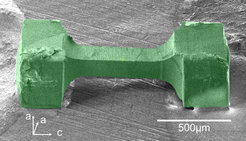The Superconductivity of Sr2RuO4 Under c-Axis Uniaxial Stress
In recent years, the Department of Quantum Materials advanced two very different techniques to probe unconventional materials: focused ion beam microstructuring and uniaxial pressure. The former uses focused Gallium or Xenon ions to typically sculpt materials in microstructures, which have often only a fraction of a hair’s width in size and are ideal to investigate transport phenomena. The latter tunes millimeter sized samples, such as unconventional superconductors and other quantum materials, to discover new phases and states of physics.

In a new work [1], a group of scientists from the MPI CPFS in collaboration with international groups from Stockholm, Tsukuba, Oxford, Toronto, St Andrews and Birmingham combined these two techniques to achieve a record value of uniaxial pressure for the unconventional superconductor Sr2RuO4. First, a focused ion beam was used to sculpt a millimeter sized single crystal, which is roughly a factor of 50 larger than typical microstructures, of Sr2RuO4 into a dumbbell shape. Only by combining microstructuring and uniaxial pressure could this structure then be compressed to more than 3 GPa (30000 atmospheric pressures, equivalent to 4 elephants balancing on a stiletto heel) along its out-of-plane (c-axis) direction. The dumbbell shape enabled high pressures to be reached in the narrow neck at the center of the sample whilst, at the same time, allowing strong bonding of the sample at its large ends.
Under these high pressures, the superconducting state of Sr2RuO4 evolved surprisingly. In contrast to a previous uniaxial pressure study under in-plane (a-axis) pressure [2], where a collective increase of the superconducting properties (Tc and Hc2) was found, applying c-axis uniaxial pressure resulted in a distinct and unexpected behavior. The upper critical field increases as expected, given calculations predict an increase in the electronic density of states. However, at the same time the superconducting transition temperature decreases. The reason for this contrasting behavior is still a mystery, but it may provide vital clues for the quest to understand the long-discussed unconventional nature of the superconducting state of Sr2RuO4. More generally, the combination of the focused ion beam technique and uniaxial pressure opens a new and promising route to investigate quantum materials in the future.
[1] Jerzembeck et al., Nature Communications 13.1 (2022)
[2] Steppke et al., Science 355.6321 (2017)












